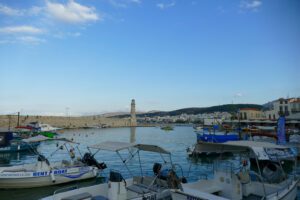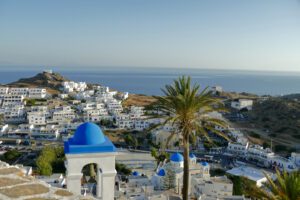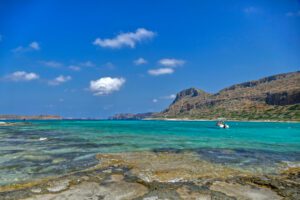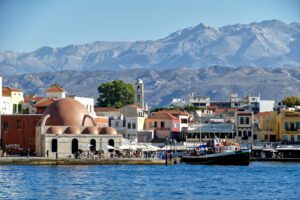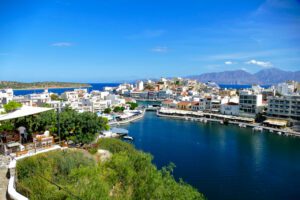Exceptional beaches, picturesque mountain villages, hikes between sheep and olive trees, antique temples, and a mysterious hotel ruin: Here are the five best things not to miss on Naxos.
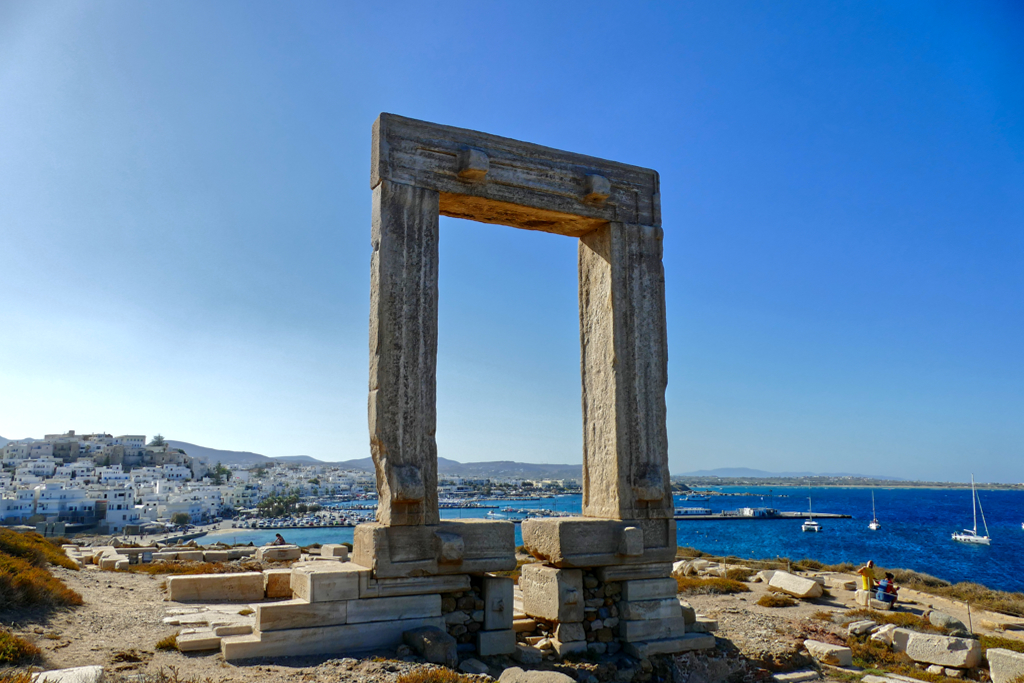
So pack your swimsuit as well as your hiking boots and follow me to Greece’s largest and arguably most amazing island.
Five Days in Naxos
Naxos is the largest of the Cyclades and therefore also the most varied one. I’d argue that every visitor to the island finds at least one thing he or she is passionate about: Are you searching for the great Greek history, basically the cradle of European culture? Then Naxos’ archeological sites will amaze you. Do you want to hang out on a secluded beach? No problem, you’ll find more hidden bays than you have ever expected. Immersing yourself in Greek everyday life? Hop on a public bus and visit the picturesque townlets and villages in Naxos’ hinterland. Oh, you are looking for the good life, for luxurious cocktails enjoyed on cozy sunbeds at posh beach clubs? You won’t have to search for long!
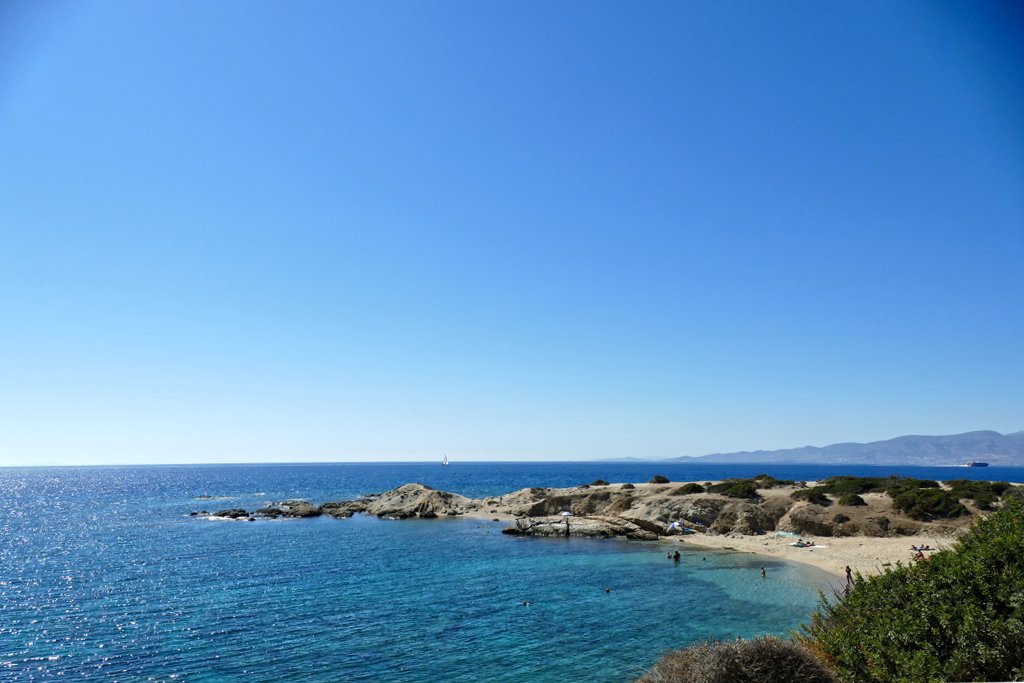
On my recent trip to the Cyclades, I spent five days on Naxos. I should rephrase this to only five days since the island has so much to offer that you won’t get bored even if you stay for five weeks. Nevertheless, as I packed my humble five days to the brim with amazing and fun activities, I can easily inspire and inform you about the five best things to do in five days.
So yes, gimme five, and then let’s check out what Naxos has in store.
History in a Nutshell
What? History? I thought we are having some fun! Relax, I certainly will not bore you with all the details about Naxos’ grand history. However, some background info will make your stay even more enjoyable as you will understand why there are Byzantine churches, Venetian castles, clandestine monasteries, and the like.
According to Greek mythology, Zeus, the father of the Gods, grew up in Naxos. Zas mountain, hence, the mountain of Zeus, was his birthplace. Today, it is the highest peak not only of Naxos, but of all the Cyclades. His son, the wine God Dionysus, also spent his life on the island where he married Ariadne on Naxos.
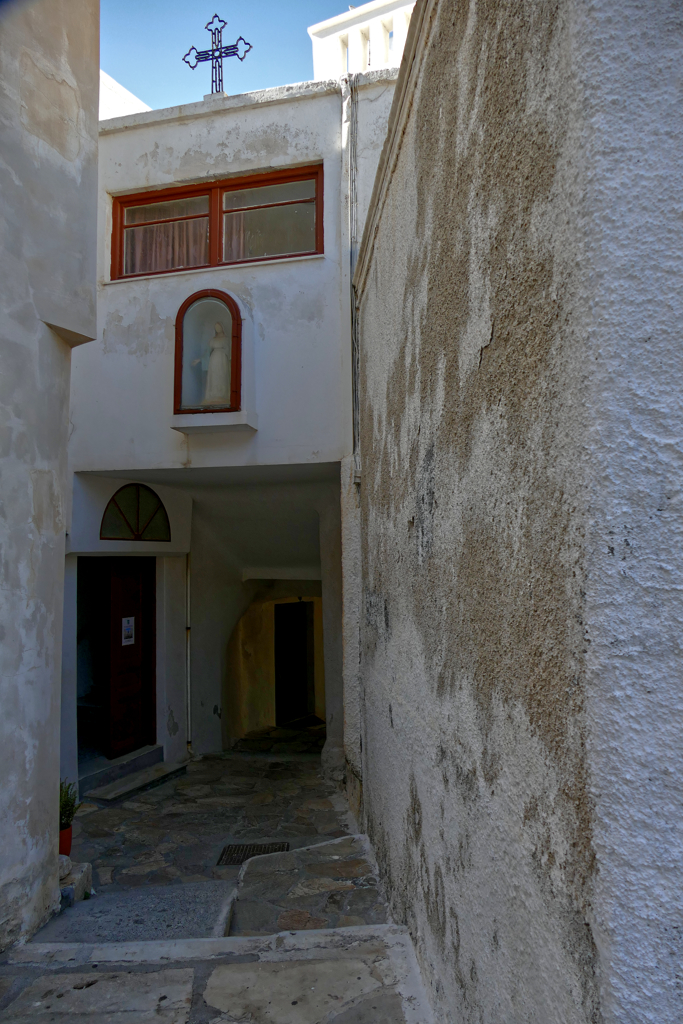
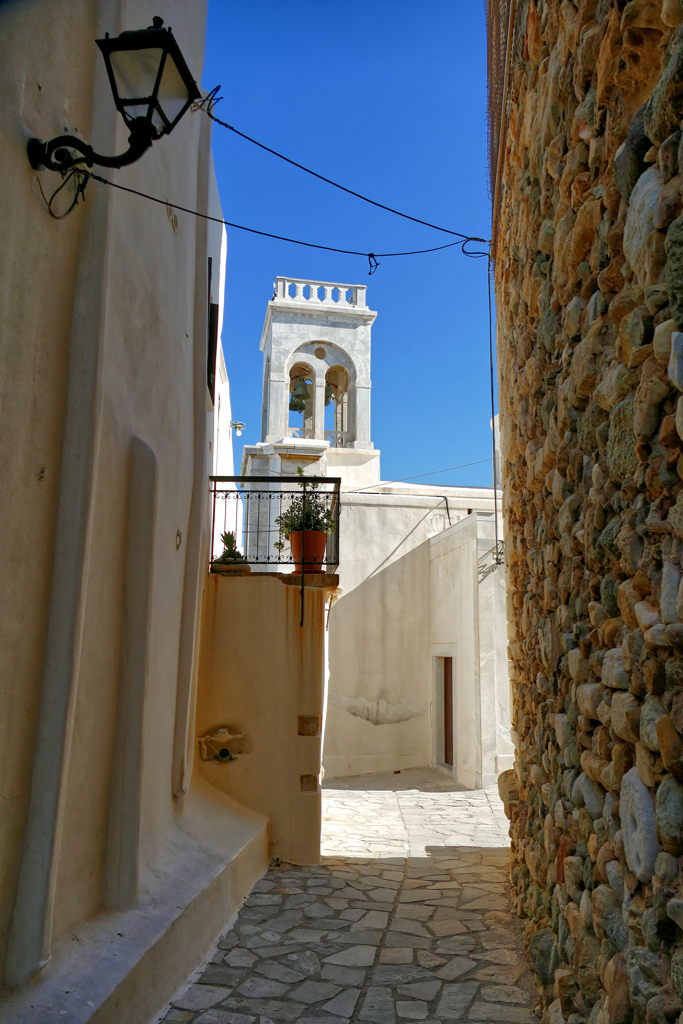
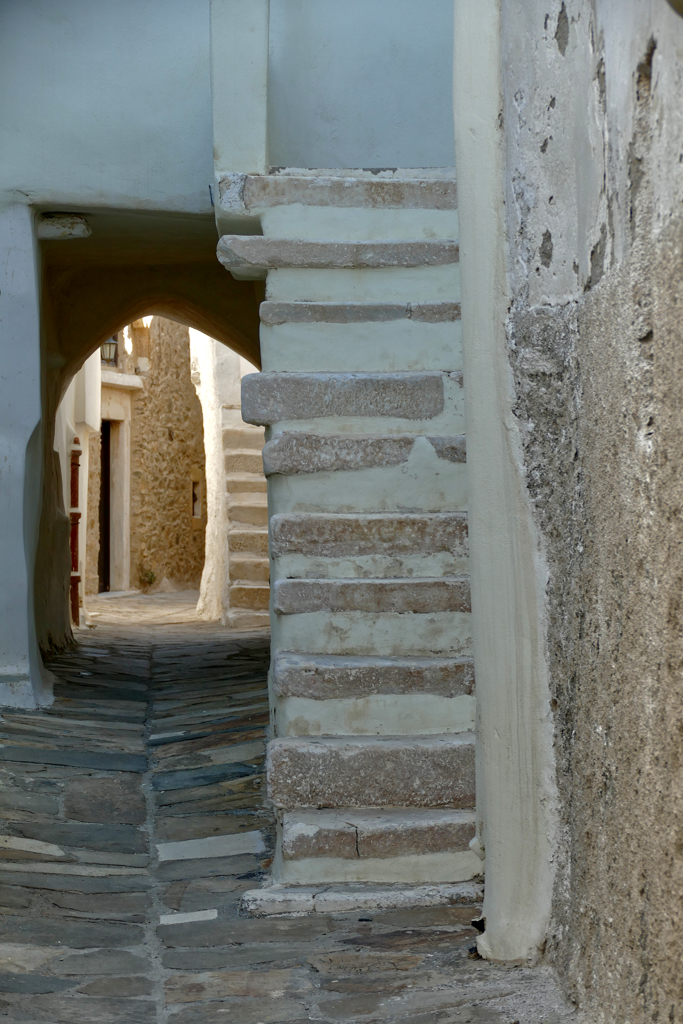
From 395, Naxos was part of the Byzantine Empire. After Byzantium collapsed, the island was conquered by the Venetians in 1207. From here, they expanded the Duchy of Naxos throughout the Cyclades. Various fortresses, as well as residential palaces, are witnesses from that past. Then, in 1566, the Ottomans conquered the island. The island became part of the newly formed state of Greece only in 1827.
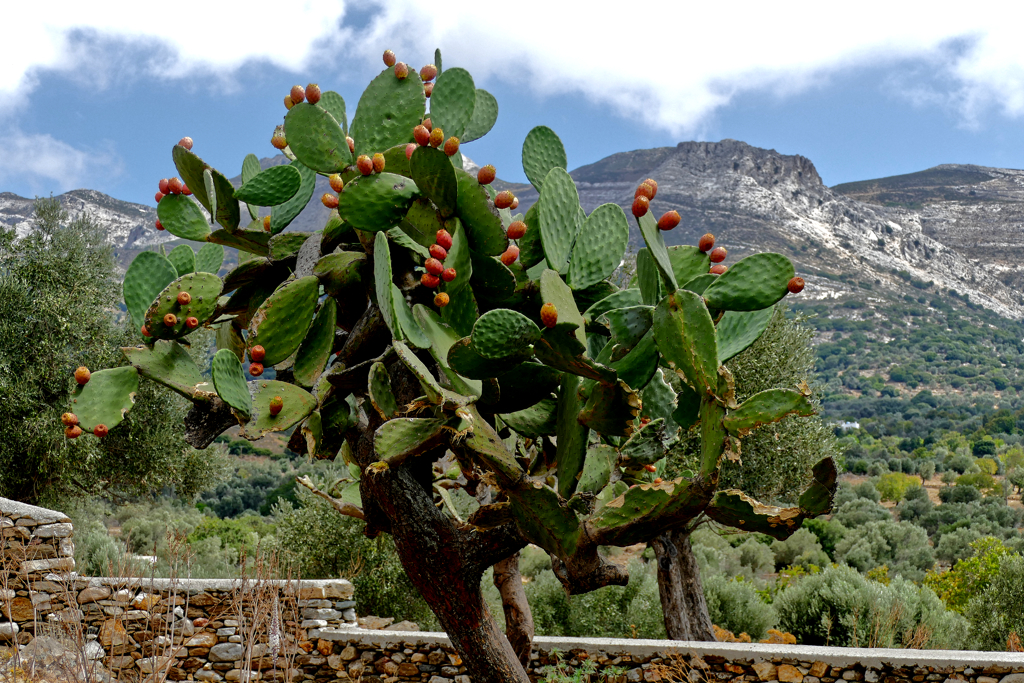
Today, Naxos is the largest and at the same time the most fertile island of the Cyclades. Thousands of olive trees cover the island’s hinterland, called Tragea. Interestingly, Naxos is also known for excellent potatoes.
Another significant economic element is the quarrying of high-quality marble. And obviously, tourism is an important factor, especially on the west coast.
1 Chora Naxos
Yet another Chora? Yes, as on many of the Cyclades, the capital is either called by the island’s name or simply Chora. This is where more than half of the islanders reside.
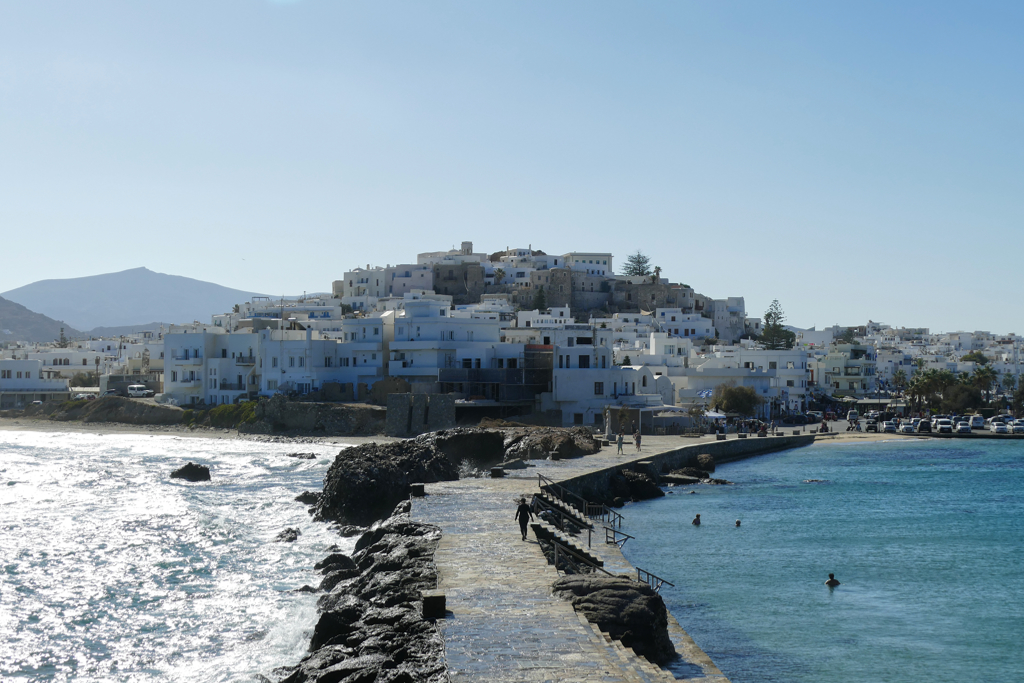
North of the city right next to the harbor stands the imposing Portara on a headland. This gate is the last relic of the ancient marble temple dedicated to Apollo. Apart from this captivating first sight, visitors to Naxos are greeted by the charming little church Panagia Mirtidiotissa. It stands on a small island across from the port’s promenade and can therefore be accessed exclusively by boat.
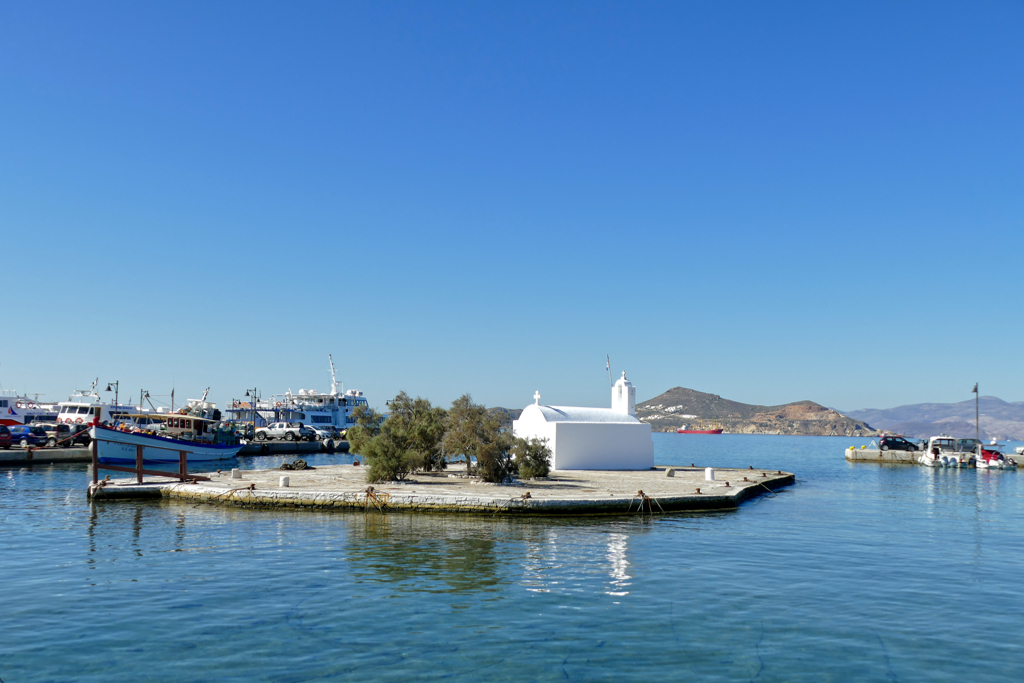
A Venetian castle complex towers on a hill over the island’s capital. This tower is the only one of twelve defensive towers still standing. Inside the fortress are the Archaeological Museum, Naxos’ Catholic Cathedral, and some Venetian mansions.

After the four-storeyed medieval castle has protected Naxos’ residents against pirate invasions for decades, it now houses taverns and darling souvenir stores, and specialty shops.
Going to the Chapel
Obviously, there are several churches worth a visit, amongst them the Saint Nikodimos Holy Orthodox Church which was built in the late 18th century. It’s in the residential area on the outskirts of the old town. Actually, the apartment that I rented during my stay in Naxos is very close by. If you want to stay in a less touristy area and still close to the action, I can wholeheartedly recommend this neighborhood. It definitely felt like home away from home.
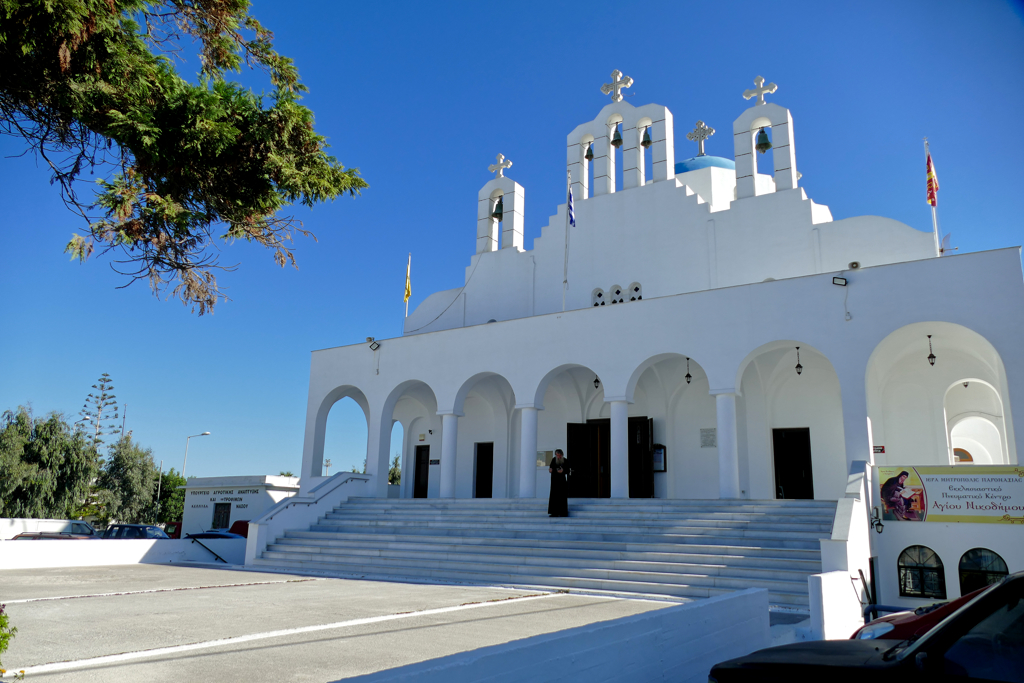
Another notable church in the Chora is Saint Kyriaki. During the Turkish hegemony, it was a monastery and functioned as a clandestine school for the oppressed locals. Also, not far from the Catholic Cathedral stands the little church of Panagia Theoskepasti where you can admire some exquisite icons of the Cretan School.
By the way, you’ll spot locals getting water at some public fountains around town – and you might want to do so, too. This water comes straight from the mountains and is super-fresh. So fill your water bottle since it’s a great alternative to tap water.
Waters
Talking ’bout water: There is great swimming right off the shores of the Chora. Between the port of Naxos and the headland of the Portara is a manmade bay. As it is sheltered from three sides, it’s very safe to swim there. Interestingly, I’ve only seen locals taking a refreshing dip, no tourists. The reason might be that there is no beach. You can leave your stuff on the causeway leading to the Portara, but there is no space for relaxed sunbathing. Also, once it gets very windy and the sea gets rough, you should refrain from swimming here. But I’m sure once you see what the sea gets like, you won’t risk your life, anyway.
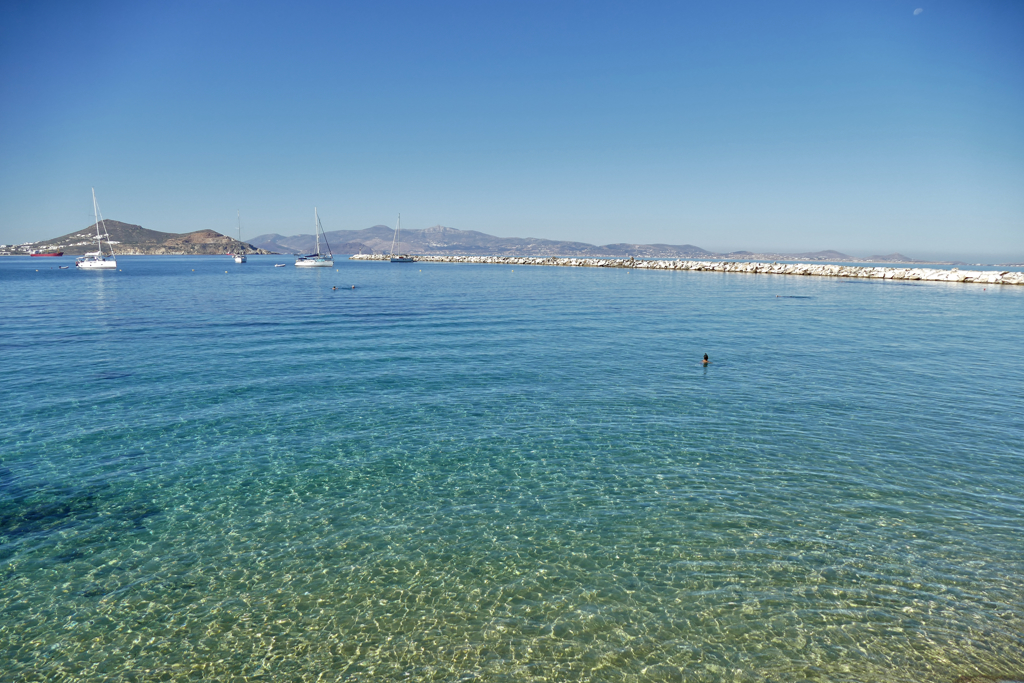
On the other side of the causeway is Grotta beach. Here, remnants of one of the Aegean’s most significant Mycenaean settlements were found.

Grotta is a small beach consisting mainly of pebbles. The water is clear, and from this location, you have an amazing view of the Portara to the left and the hills to the right. This being said, it deems a bit scruffy and dirty probably since it’s not very touristy. Also, since Grotta is opening toward the north, the waves here become really forceful once the wind gets stronger.
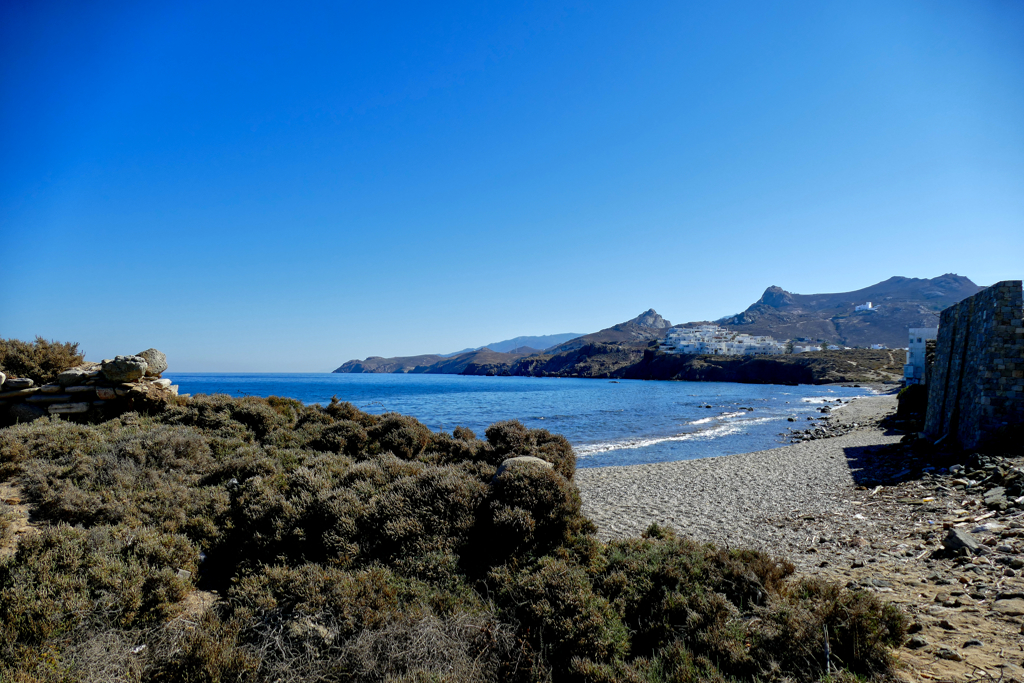
I’d argue, spending a beach day at Grotta is an option, however, by far not the best one. The following chapter will prove my point.
2 Beaches And Ghosts
Naxos is said to have the best beaches in the Cyclades, maybe even in all of Greece. I haven’t been to all of Greece’s beaches but I can confirm that some of Naxos’ beaches are simply incredibly beautiful.
Never in my life have I seen waters so clear – unless we are talking ’bout my bathtub. As it gets deeper, its color changes from a light turquoise into a darker shade of petrol green and finally into an ink blue. Simply mesmerizing.

Due to geological and meteorological conditions, the best beaches are on the western coast. Basically, the entire coastline consists of coves and bays and long stretches of fine sand.
The most popular ones are in the northern part. Whether Agios Georgios right on the outskirts of Naxos’ Chora, Agios Prokopios, or Plaka beach, these long sandy beaches cater to every vacationer’s needs. You can rent sunbeds and parasols for a fee depending on the business as well as the season. Behind the beaches are bars and restaurants, convenience stores and souvenir shops as well as businesses offering water sports gear and boat trips.
What I particularly like about Naxos’ beaches is the fact that you don’t have to rent a sunbed. If you are coming for just an hour in the sun and a quick dip, you can just spread out your beach towel and nobody bothers you. Also, there are enough trees and bushes so that you don’t have to fry in the noonish heat just because you aren’t willing to fork out 20 €uros for a spot under a parasol.
Going South
The further south you get, the more secluded and serene are the beaches. From Mikri Vigla beach southwards it’s simply paradise. If you are an avid hiker, I’d recommend walking alongside the water all the way to the peninsula of Alyko. This should take about two hours, and you don’t have to do it in one go, obviously. Just start walking and as you get to the charming little cove that seems to whisper your name, just spread out your towel and enjoy the solitude for a moment before you continue to the next little piece of heaven.
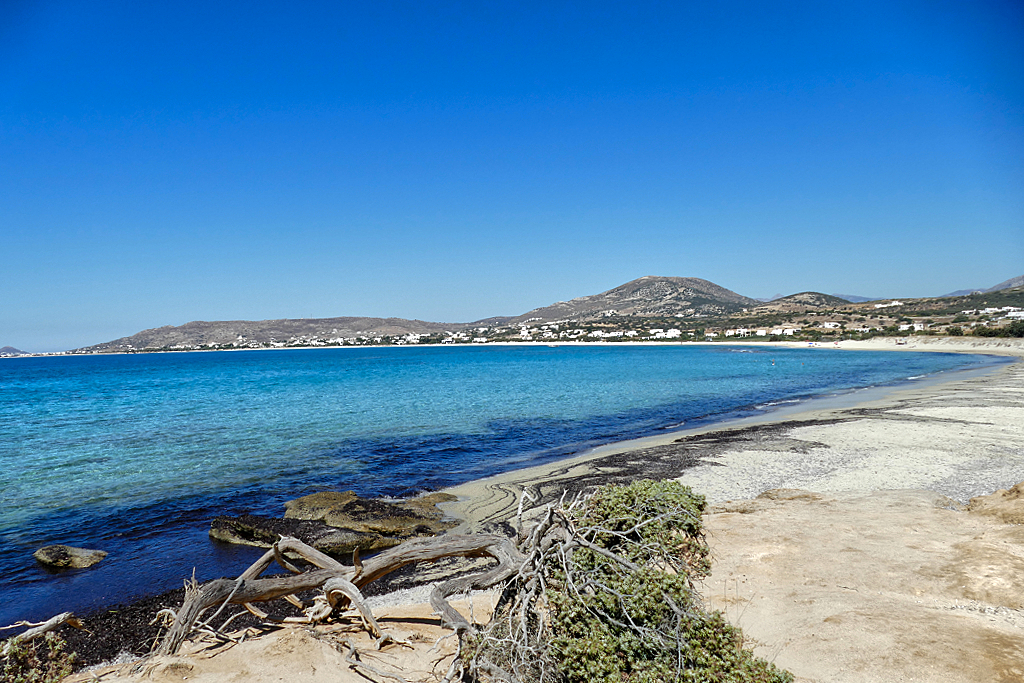
This way, you’ll pass through Kastraki and Glyfada beach before you reach the cedar grove on the northern side of Alyko. Crossing the grove can be a bit challenging since the shrubs are sturdy and prickly. Try to stay on the very narrow sandy trails.
Alyko is actually a small peninsula with various sandy beaches and coves, it caters to every taste. Behind the dense cedar tree forest is Kedros Beach, a fantastic white sand beach that is mainly popular among nudists.
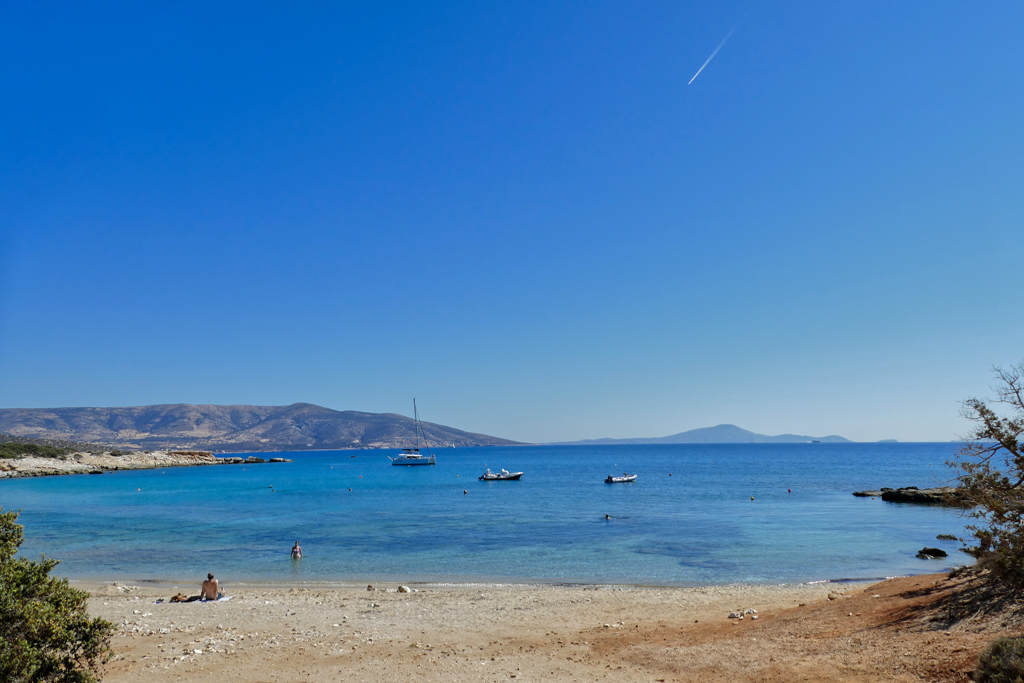
Then comes Hawaii Beach, which I still find quite funny. It is below a 10 meters high cliff. Rock formations separate it from Kedros beach in the north and Mikro Alyko, a small sandy beach in the south. Finally, there is the true and one and only Alyko Beach which is the most popular of them all. Not only is it in a quite spacious bay. Contrary to the other beaches on the peninsula, access is also easiest. Yet, it is an ideal beach for those who seek privacy.
The waters surrounding the peninsula of Alyko are also the perfect grounds for snorkeling in Naxos.
Be Prepared
The disadvantage of these remote beaches is the lack of infrastructure. You have to bring everything you need with you. Therefore, I put together a pack list for a day on a secluded beach. You find this list at the end of my post The Best and Most Beautiful Beaches of Naxos where I’m introducing Naxos’ eight most alluring beaches in detail. Also, you’ll get comprehensive info on how to visit them comfortably by public bus.
The northern coast of Naxos also offers numerous beaches and wild bays. However, it can be a bit challenging to get there. Also, the sea tends to be rougher and the winds more powerful.
An Unexpected Open-Air Gallery
Alyko Beach is not only famous for its many idyllic secluded bays. It has actually a real landmark.
Pretty much in the center of the peninsula is a long-abandoned and uncompleted hotel complex. Supposedly, it stems back from the days of the military Junta in Greece. It is believed that as the government changed, this construction was considered illegal. Even as you look at the ruins today, you’ll realize that this was a completely disproportionate project. Believe it or not, the hotel was planned to have 1,000 rooms! A chunk like this would have totally destroyed the beauty of Alyko and the peninsula’s distinctive biotope. Fortunately, after decades of disputes, this crazy project was simply abandoned.
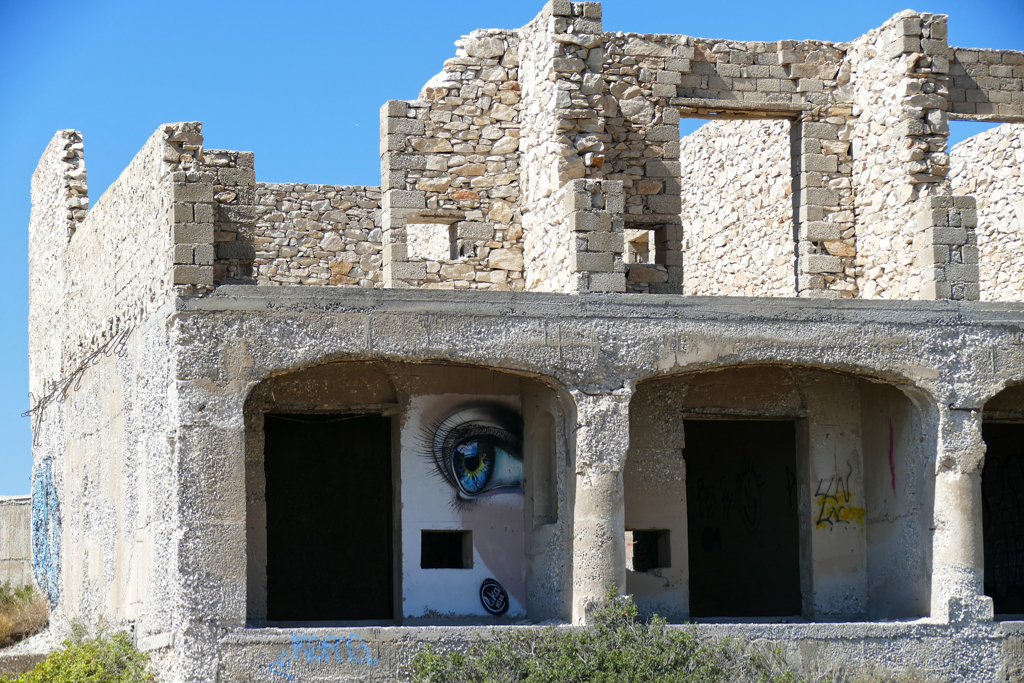
Today, those decaying buildings provide amazing opportunities for street artists mainly from Greece but also from other parts of the world. As a matter of fact, the Hotel Ruins of Alyko became one of the top attractions on the island.
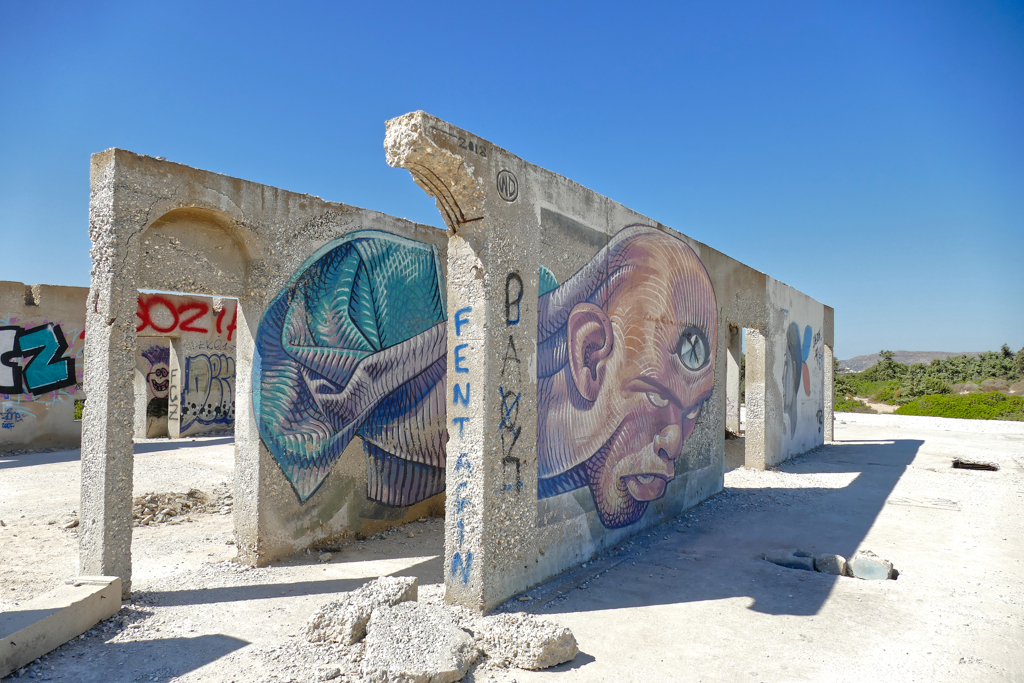
You know that I’m a street art buff. Since this post is designed to provide you with inspiration and info about various glories of Naxos, I’m not going further into detail about the artists that contributed to this quirky open-air gallery. Nevertheless, I wrote another post dealing exclusively with the Amazing Murals of the Hotel Ruins of Alyko.
3 Villages
I prevent you that this is just a short roundup of Naxos’ most picturesque townlets. But don’t worry, I’ve put together an entire post dealing exclusively with the five most beautiful villages, their history, and the most significant spots. The best thing is that in said post, I’m showing you how to visit them easily and comfortably by public bus even in just one day. This way, not only do you save a lot of money. Travelling by bus also spares you driving the crazy serpentines and searching for a secure parking spot. Hence, let the driver do the job while you enjoy the scenery to the fullest.
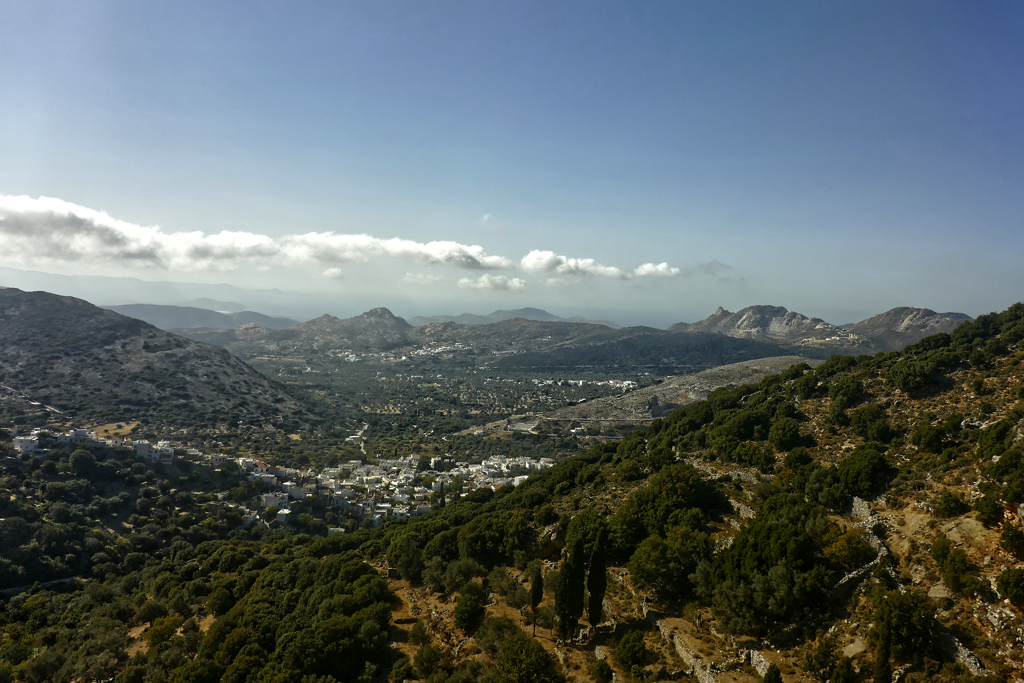
Naxos’ countryside is incredibly captivating. Picturesque little villages are scattered high up in the mountains and the lush valleys. Add a couple of Venetian towers, tons of Byzantine monasteries and churches, and some quaint cemeteries and you get the picture.
Just southeast of the Chora lies the village of Galanado. Here, you get to admire the Venetian Tower of Belonia as well as a small chapel dedicated to St. John. The unusual little church from the 13th century is a Catholic chapel on the left side. On the right is an Orthodox chapel.
Vivlos – Sangri – Chalkio
Through the traditional village of Vivlos with its characteristic windmills, you’ll get to Sangri. It is located on a hillside and surrounded by fields and farmland. Here, you can visit a couple of Naxos’ most iconic Byzantine churches. Also, the old monastery of Agios Eleftherios is highly interesting since it served as a secret school during the years of the Turkish occupation.
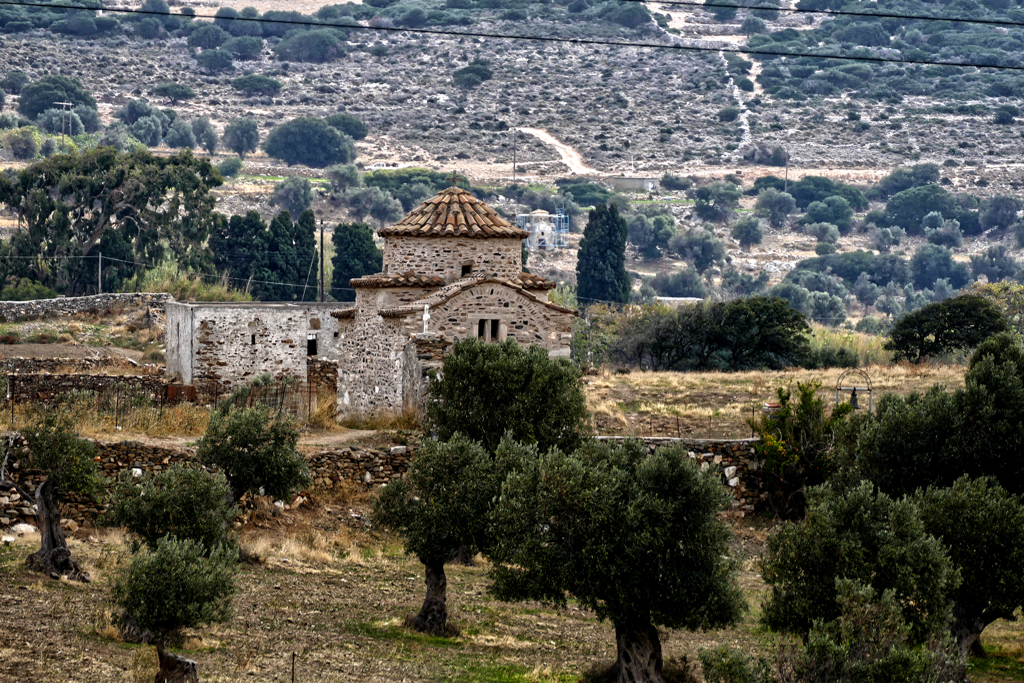
The highlight, however, are the ruins of a temple dedicated to the goddess Demeter in the 6th century B. C. You’ll find a detailed description in the Churches and Temples section below.
Passing the posh settlement of Damarionas the bus will take you to Chalkio. Back in the day, this townlet used to be Naxos’ capital and its administrative center.

To this date, the neoclassical buildings will just amaze you. The bus stop is right in front of the church Panagia Protothronos from the 9th century. The region of Tragea around Chalkio is the principal olive cultivation area of the Cyclades and is also packed with precious Byzantine churches. Therefore, the trails around the village are a very popular hiking area.
Filoti – Apeiranthos – Koronos
Just minutes east of Chalkio lies Filoti. As a matter of fact, it’s so close by that you can get there by walking. You’ll find a guide to this easy and short hike below.
Filoti is built in the shape of an amphitheater on the foothills of Mount Zas. Obviously, it’s the best spot where to start your climb up Naxos’ highest mountain.
In the center of town are a couple of lovely squares and churches. Actually, when exploring the Tragea, Filoti is the best place to take an extended break and enjoy a lovely traditional supper.
From Filoti, the road winds in serpentines all the way to the beautiful village of Apeiranthos. It is one of the oldest settlements on the island and proudly preserves and presents Naxos’ traditions and local culture. Also, the views of the surrounding mountains and the Aegean sea are absolutely superb.

Apareinthos is basically made from marble. You find these precious rocks in both, its masonry and streets. Steep lanes with covered archways lead through this quaint mountainous village alongside charming whitewashed houses, decorated with colorful flowers. Yes, Apareinthos is definitely Naxos’ most beautiful townlet.
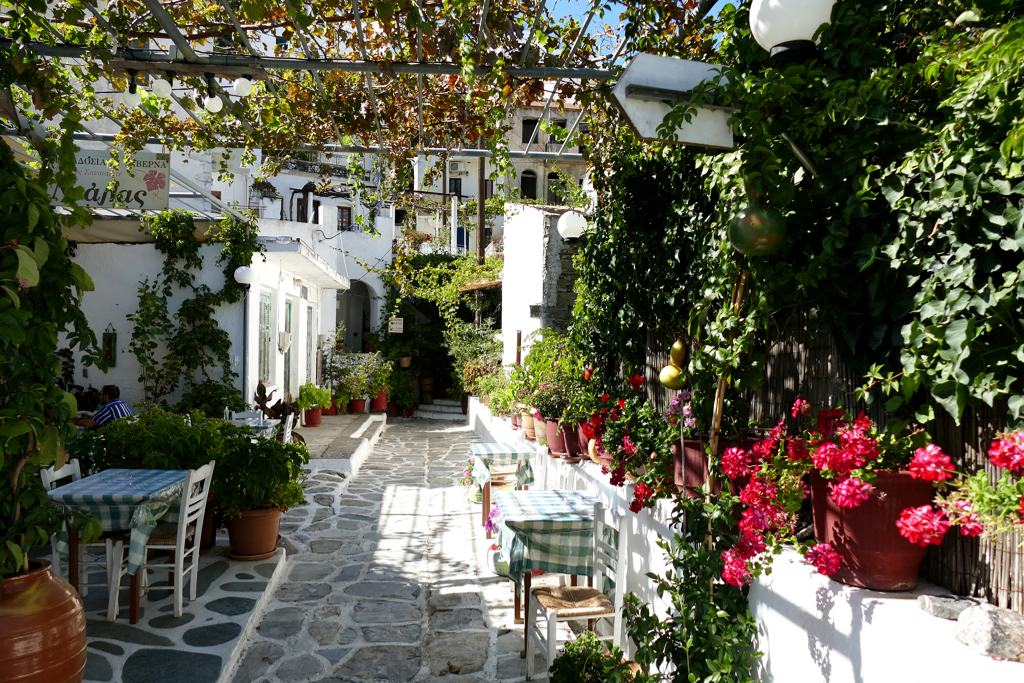
Every afternoon, you can hop on a small bus that takes you to the secluded village of Koronos. Basically cut in half by a ravine, it is set on the slopes of Mount Amomaxis and Mount Koronos. As public transport to Koronos is very limited, you have about one hour before the afternoon bus takes you back to Apareinthos. Keeping that in mind, it’s absolutely recommendable paying Koronos a one-hour visit.
4 Hikes
There are many ways to explore the island, and hiking is certainly the one that brings you closest to nature and Naxos in ye olden days. You can choose from easy walks on paved trails to adventurous treks up the mountains. Below, I’m listing three hikes that should be feasible for every halfway-fit person. Nevertheless, especially after my hiking accident in Gran Canaria, I’d urge you not to go hiking by yourself and to heed the following recommendations:
- Wear sensible shoes. Sneakers with a good profile might be okay for the hikes around Chalkio. If you are planning on going up Mount Zas, you should definitely wear high-quality hiking boots.
- Trekking poles are not really necessary but they definitely make your hiking easier.
- To protect your legs against abrasions from the bushes and also from bug bites, better wear long pants than shorts.
- If you are going up Mount Zas, you should pack a foldable windbreaker.
- Make sure your phone is sufficiently charged and check from time to time if there is a connection.
- Bring a lot of water and possibly some high-protein snacks.
- There aren’t many shady spots alongside the hiking routes below. Don’t forget to bring a hat and put on lots of suntan lotion. In summer, start hiking early in the morning.
Circular Route Around Chalkio
This hiking trail goes in a circle around the largest part of the olive grove and the Byzantine churches of the Tragea, Naxos’ fertile hinterland.
Leaving Chalkio towards the Monitsia Village in the north, you’ll find a map showing various hiking options. Trail 4 is the most popular hike since it’s not very challenging and starts and ends at the village of Chalkio.
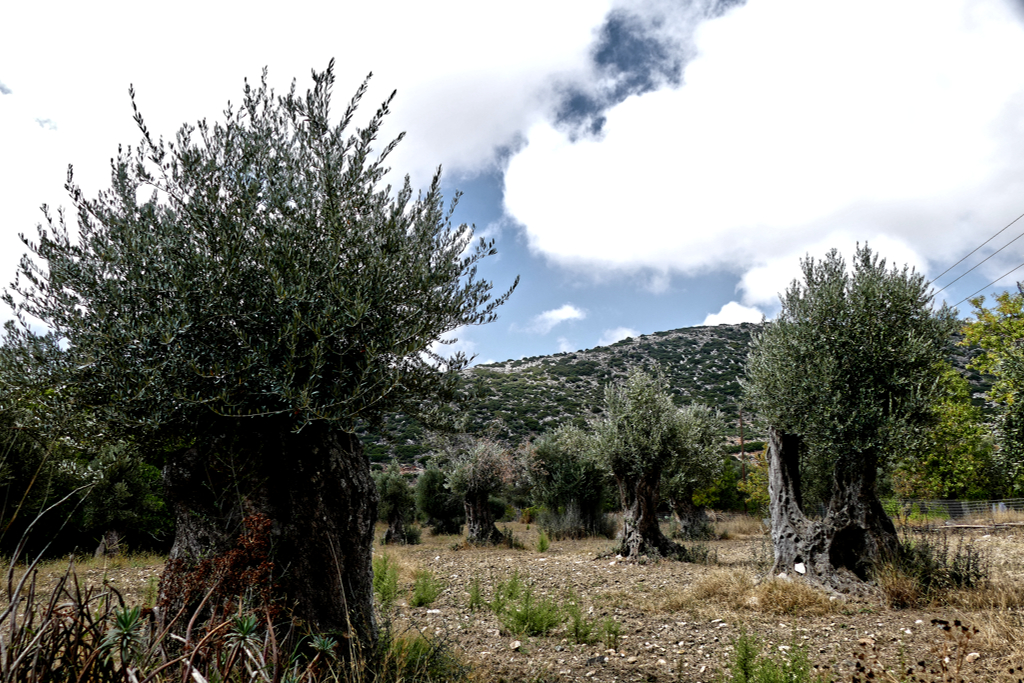
On your hike, you’ll get to see many Byzantine churches. The most famous ones are Agios Georgios Diasoritis close to Chalkio and Panagia Drosiani which is near Moni. With its three adjoining chapels that are adorned with frescoes created between the 7th and the 14th centuries it is considered the most important Byzantine chapel in the entire Cycladic region.

At 500 meters, the rural settlement of Moni is the highest point on this hike. From there, you continue back south to the village of Kaloxilos where you’ll find the Byzantine church Panagia Damiotissa. As you continue further south to Akadimi, you’ll see the Markopolitis tower. The walk then ends at the Barozzi tower in Chalkio.
Although the hike is pretty easy, you’ll pass spots that are overgrown by low but dense vegetation. Therefore, it’s better to wear long trousers that protect your calves, and sturdy hiking boots, obviously.
From Chalkio to Filoti
This is a lovely and easy hike that takes about an hour if you walk the scenic route. But keep in mind that the hike will probably take a bit longer since you will also admire the impressive scenery. Walking alongside the road takes only half an hour, but you want beauty, don’t you?
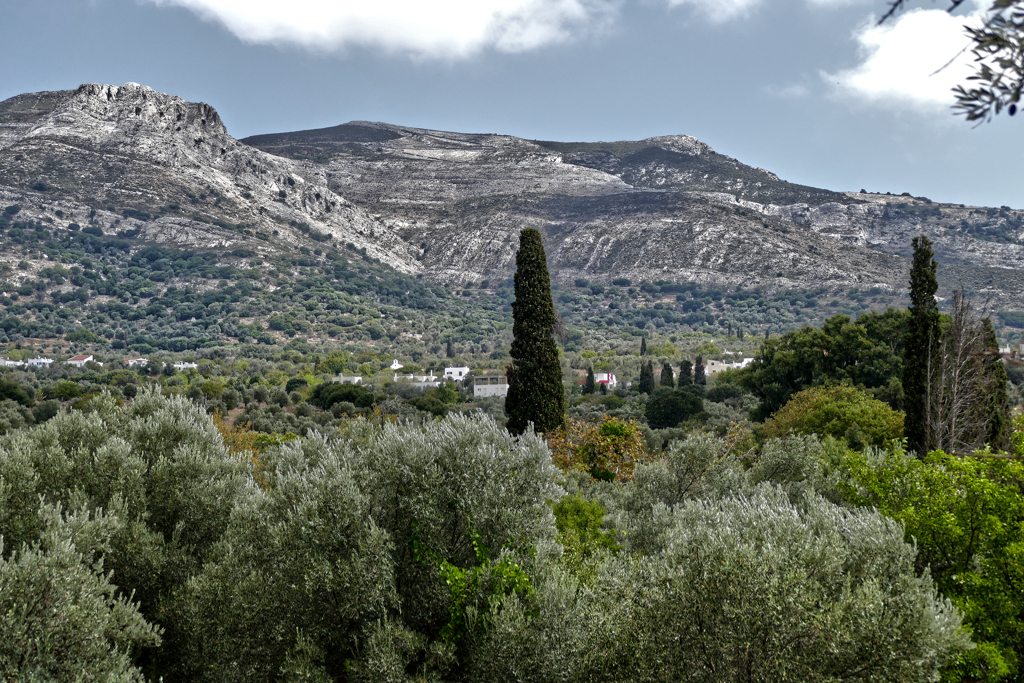
At the next fork, do not turn left towards the church of Saint Eleftherios but choose the right road. At the next fork, turn left towards the Holy Church of Saint John the Theologian.
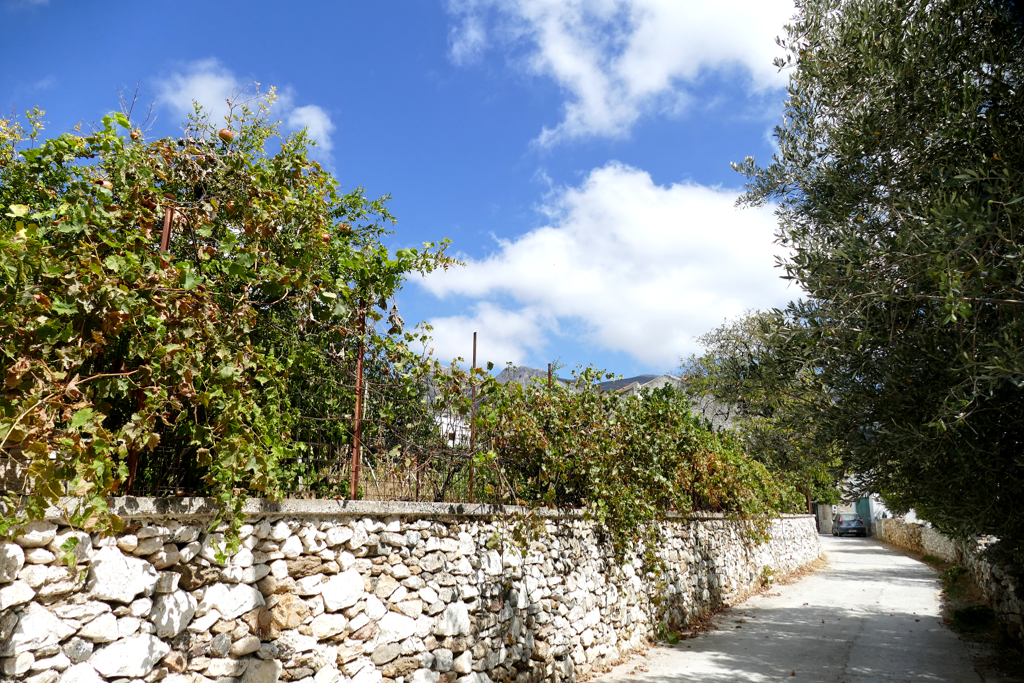
Start your hike in Chalkio at the Church of Panagia Protothronos. On the left side of the church is a narrow road leading past the Barozzi tower. At the end of the road, turn right and then right again. You’ll see the Markopolitis tower to your left and the Church of Panagia Akadimiotisa to your right. Turn left and cross the main road. At the next fork, choose the left road which will lead you past the Folklore Museum Florios Chorianopoulos through the village of Kaloxylos.
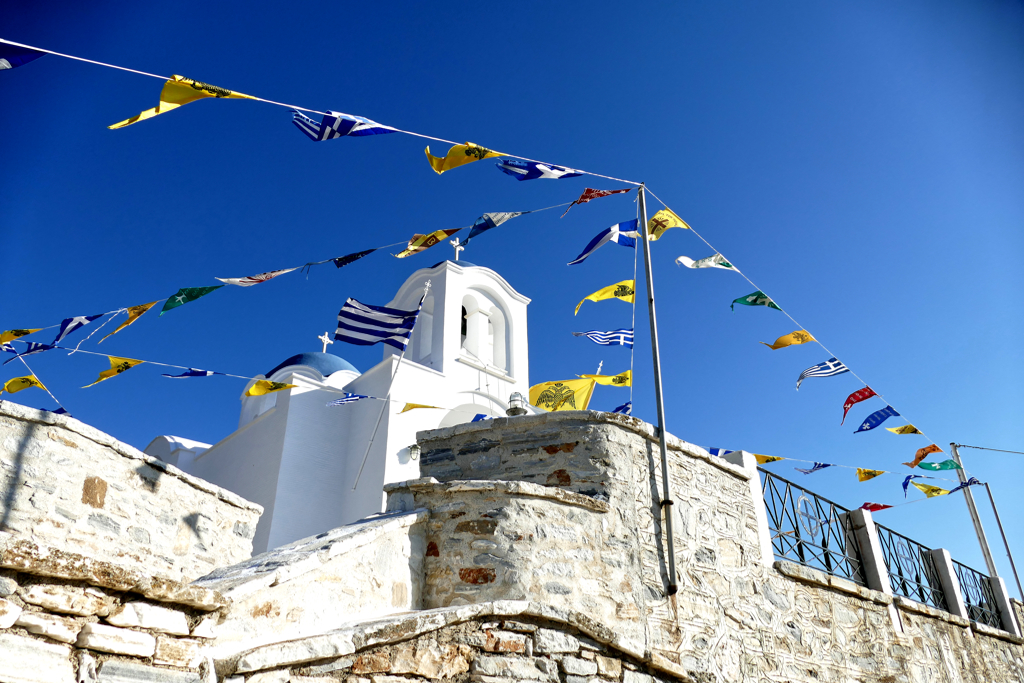
From this quaint little church, just keep walking southwards. Next, you’ll spot the Mill of Paspalitis. Here, you choose the left trail which will lead you to Filoti’s Agia Sofia church. From here it’s just a short walk downhill to the center of Filoti.
From Filoti to Mount Zas
Mount Zas was named after the father of the gods Zeus. According to legend, Zeus spent his childhood in the cave of Za, hiding from his father Saturn.
There are two routes going up the mountain. The easier one starts at the Chapel Agia Marina around 3.5 kilometers southeast of Filoti.
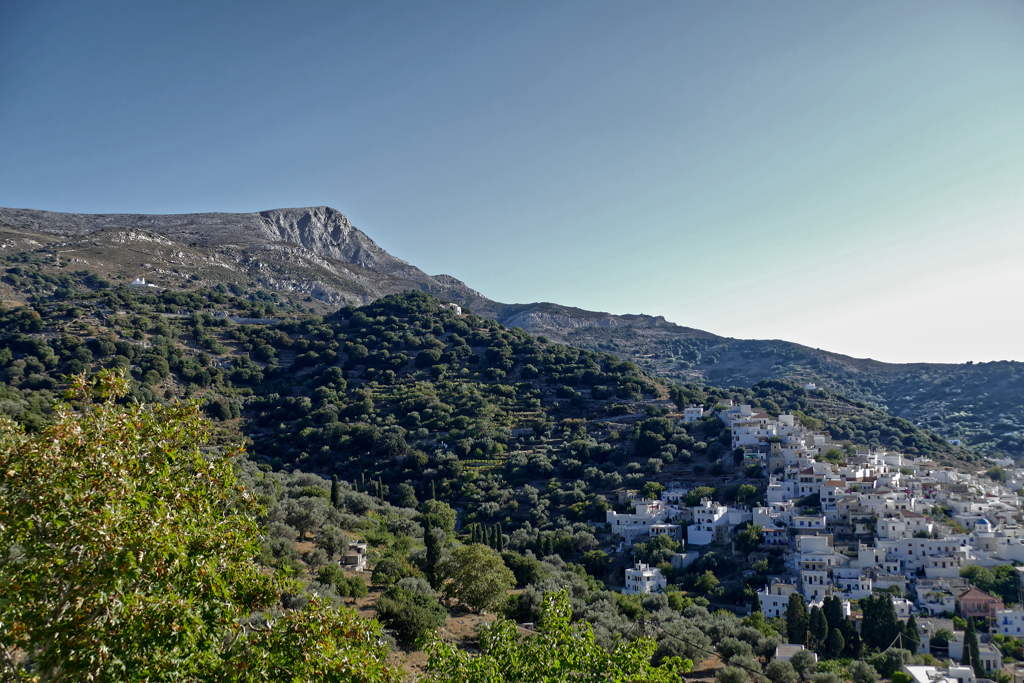
Although the climb is relatively easy, you should be halfway fit. Also, it is not recommended for small kids under the age of 10. Also, keep in mind that it can get very windy up there.
Especially during the summer months, you should consider starting your hike around 5 a. m. This does not only allow you to enjoy the sunrise. You’ll also avoid hiking in the noonish heat.
From Agia Marina, the ascent takes about an hour. The most difficult part of the route is the last leg. Here, you have to climb steeply uphill and it’s also the windiest part.
The descent will then take more or less the same time.
5 Temples and Churches
There are about 150 early Christian and Byzantine churches on Naxos many of which are painted with amazing frescoes. This gave Naxos the appreciative nickname Byzantine Pinacoteca of the Aegean. For instance, the paintings in the Panagia Drosiani near Moni from the 6th century are among the most significant frescoes in all of Greece.
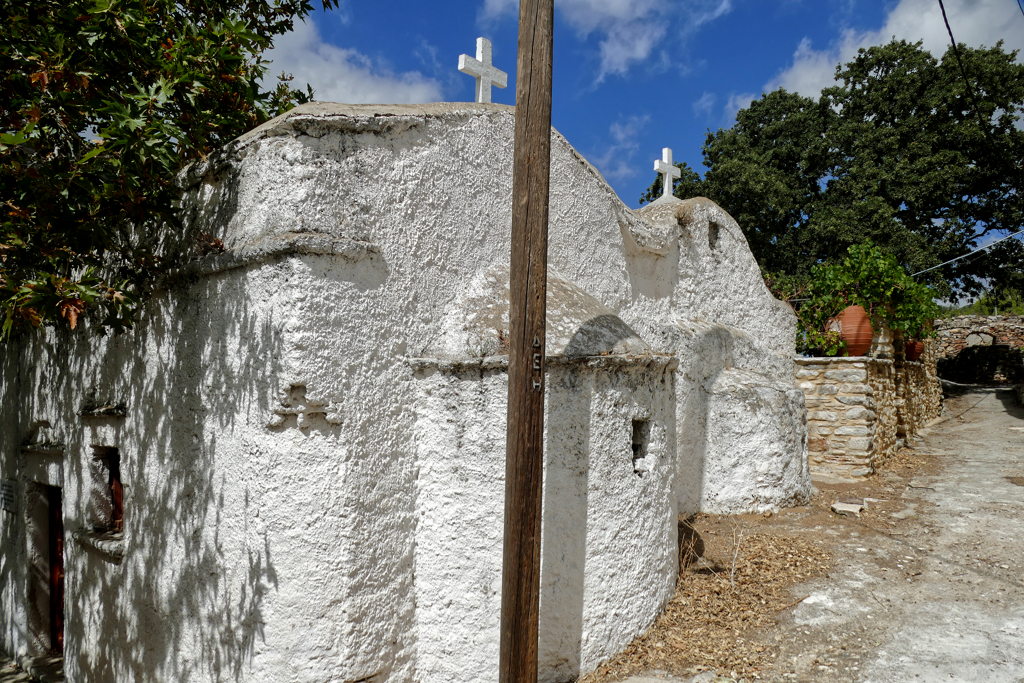
Fascinating churches are found all over the island, but mainly in the vicinity of Chalkio and Sangri. Sadly, many of them are in poor condition and some are even in ruins.
Howsoever, a place in Greece would not be a place in Greece without some amazing archeological remnants and finds. Below, I’m introducing Naxos’ three most significant temples.
Portara of the Temple of Apollo
Naxos’ most momentous archeological treasure is definitely the Portara of Naxos, a fragment of the Temple of Apollo. Actually, it’s the island’s icon. It is located on a peninsula in front of the town of Naxos from where it’s practically greeting arriving visitors.

The Portara is made from local marble and is the only preserved part of the former temple. The gate consists of a door jamb and a lintel made from marble from the quarries of Flerio about ten kilometers east of the Chora.
Construction of the temple in honor of the Greek God Apollon began mid of the 6th century B. C. but it was never completed. Over the centuries, the unfinished building was used as a quarry for other constructions. Only the heavy gate was not dismantled, possibly due to its weight.

The temple gate is standing on a peninsula off the port of Naxos. It can be accessed over a causeway. But be very careful when it’s windy since the stones are washed over by the high waves and get extremely slippery.
The Portara is Naxos’ most iconic landmark. It is particularly beautiful in the evening when the white marble gate stands out against the setting sun.
Temple of Dionysus – Sanctuary of Iria
The Sanctuary of Yria is an ancient temple complex that was dedicated to the God Dionysos. The remains of the sanctuary building were uncovered only recently at the end of the 21st century. The archaeological site is located about three kilometers south of the Chora in the village of Glinado.
Dionysus was a very much loved God as he was in charge of wine, celebration, and fun. It was believed that he lived in dense forests and was always drunk. I know a few people who seem to follow his example, but that’s a story for another time.
Howsoever, in honor of this popular God, the residents of Naxos built the large temple. Judging from the ruins, the temple was built approximately in the 6th century B. C. Interestingly, after the religion of the Olympian Gods declined, the temple was converted into a Christian church in the 5th century.
Many of the smallish finds are exhibited in a small on-site museum, others in Naxos’ Archaeological Museum.
Since the site is so close to the Chora, you can actually go there walking. However, Bus #3 also goes to the village of Glinado.
The site is open every day from 8.30 a. m. till 3.30 p.m.
Temple of Demeter
This magnificent Temple of Demeter dates back to the 6th century B. C. and has been made exclusively from the finest Naxos marble. Since it is completely curved, each individual component had to be manufactured individually for its purpose. It is one of the early Ionian temples. As Demeter was the Olympian Goddess of agriculture, harvest, and fertility, the fertile grounds around Sangri were chosen to build the temple.
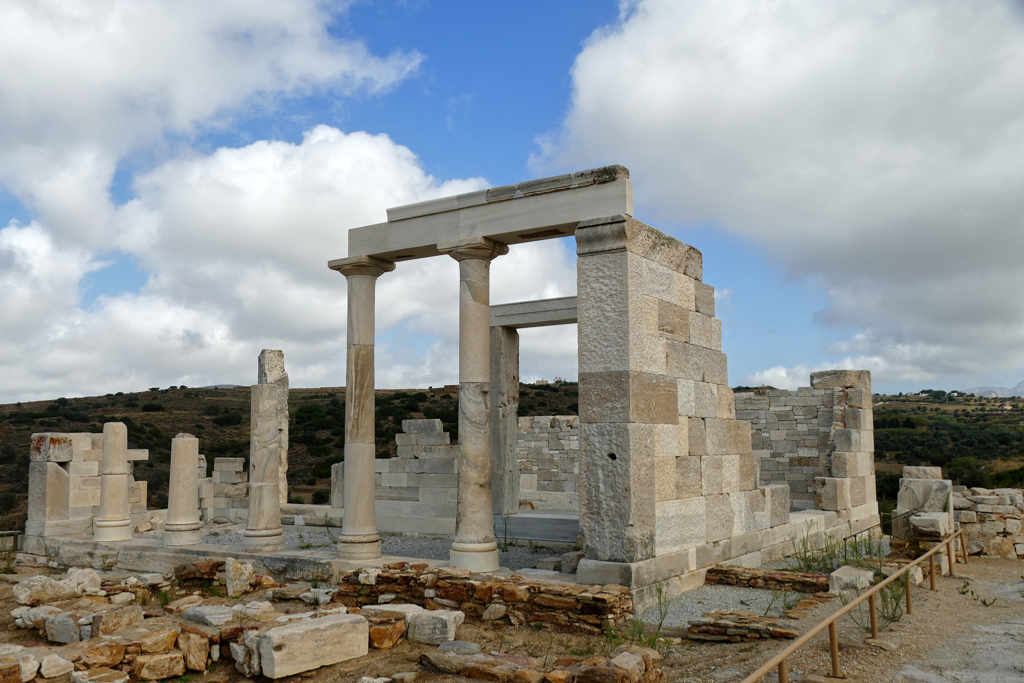
Around the 3rd century, Christianity repressed the Olympian deities. Hence, the temple of Demeter was converted into a Christian basilica, dedicated to Saint John. Said church was probably destroyed in the 7th century during an Arabic invasion of the island.
The remains of the ancient temple of Demeter were discovered only in 1949. During the excavations that took place in the second half of the 21st century, fragments of the temple were recovered from all around the area but sadly, many had been looted.
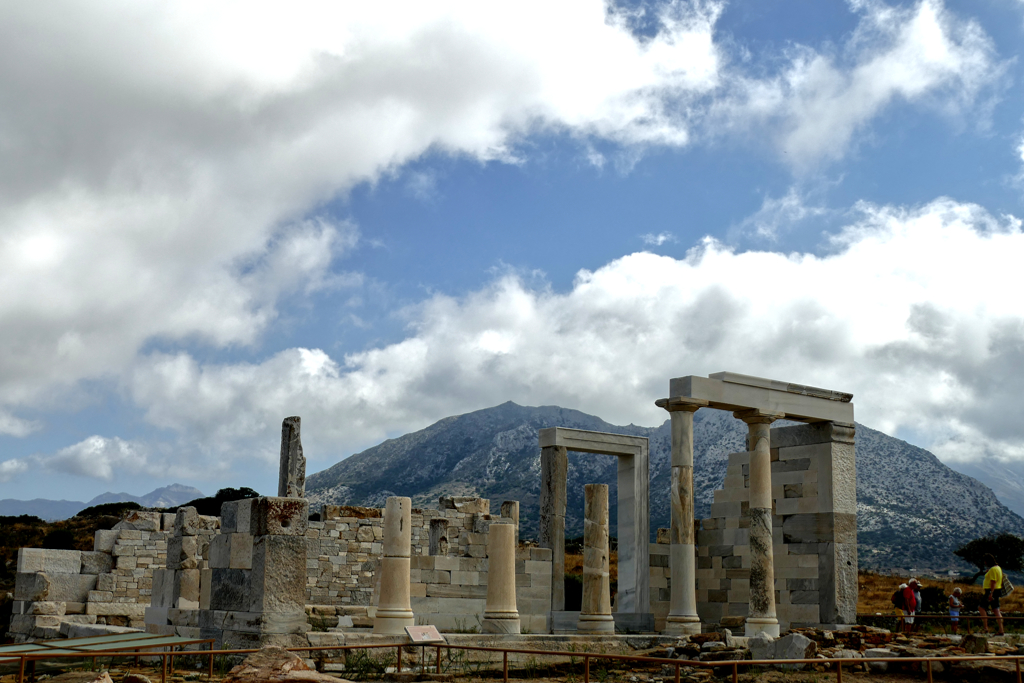
Today, the Temple of Demeter is one of the most alluring ancient Greek temples, especially due to its scenic location amidst the green fields of Sangri.
Parts of the temple that were not used for the restoration are exhibited in a small museum next to the archeological site.
The museum is open every day except Tuesdays from 08:30 to 15:30. Entrance to the outdoor archeological site is free.
Practical Information
How to Get There
By Plane
This chapter will be amazingly short for the sole reason that there is no international airport in Naxos. The island’s airport caters only to small planes. There are no international flights to the island. Commercial flights are only scheduled from Athens by Olympic Airways. However, you can also travel from Athens to Naxos by ferry.
If you are also visiting some of the other Cyclades, like for instance Mykonos, you can also check out flights there. I actually came to Naxos by ferry from Heraklion on the island of Crete after having spent a couple of days on Santorini and Ios.
By Ferry
Ferries are going to Naxos from the neighboring island of Paros as well as from Santorini, Ios, Heraklion on the island of Crete, and from the port of Piraeus in Athens.
There are different standards of ferries, and prices differ accordingly. You can check prices and book tickets online, for instance at ferryscanner.com or directferries.co.uk. On all ferries, you can buy some kinds of snacks and drinks, hence, you do not need to bring them on board if you don’t want to.

Since you have to leave larger pieces of luggage in the boarding area and have to climb to the upper decks to find your seat, make sure to pack all your valuables in a smaller piece of hand luggage that you can have with you all the time.
If you have a flight to catch or any other critical connection, always keep in mind that the scheduled times are subject to change at any time. If those are foreseen, the ferry company will inform you. Yet, delays can also occur on short notice.
Therefore, I would never book a flight for the same day.
How To Get Around
Bus
As in all of Greece, the most important means of public transport are the buses operated by the company KTEL.
Everywhere I went, the system of public transportation was comprehensive and very reliable. Obviously, there are only a few – sometimes even only one – connections to more secluded places. However, if you are halfway organized, you can still easily explore the island of Naxos by bus.
Nevertheless, in the off-season during the winter months, some connections to secluded places might be suspended.
Keep in mind that buses don’t always stop at every designated stop on their itinerary. Therefore, make sure to let the driver know where you want to get off as you enter the bus.
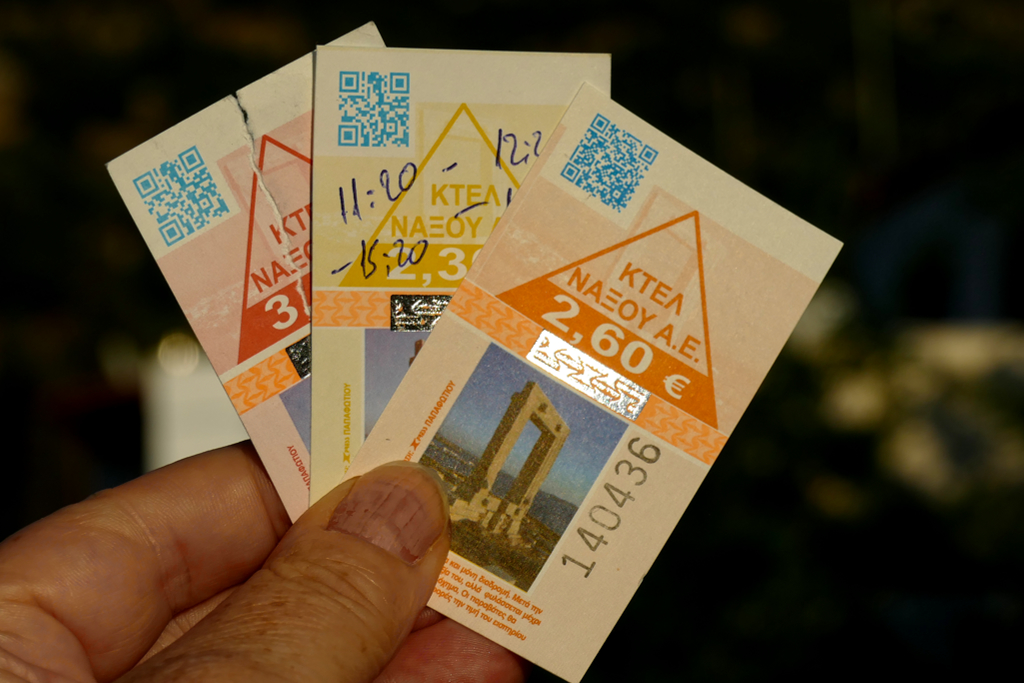
I visited all the places introduced in this guide comfortably by public bus. Nevertheless, as schedules are subject to change, I’d recommend checking the bus company’s comprehensive website. Also, the ladies at the KTEL bus station in Naxos’ Chora are very helpful. If you have already determined your plans for the day, you can buy all your tickets there in advance. And don’t worry about changing your plans: You can still utilize unused tickets for other trips, which have to be at the same price, obviously.
Either way, you have to get your ticket in advance before boarding the bus. Apart from the main bus station, kiosks and mini markets are selling bus tickets, too. You cannot buy tickets from the driver.
Rental Car
Although the bus system is really great, I won’t argue that the ideal means of transport for visitors might still be a rental car. It’s the only way to explore the entire island at any time comfortably at a flexible pace.
Although the road conditions vary, they should be easy to drive on. However, you should always keep an eye on potholes or herds of sheep and goats crossing your way.
Boat
Especially during high season, visiting more secluded bays’n’beaches by boat is a wonderful experience.
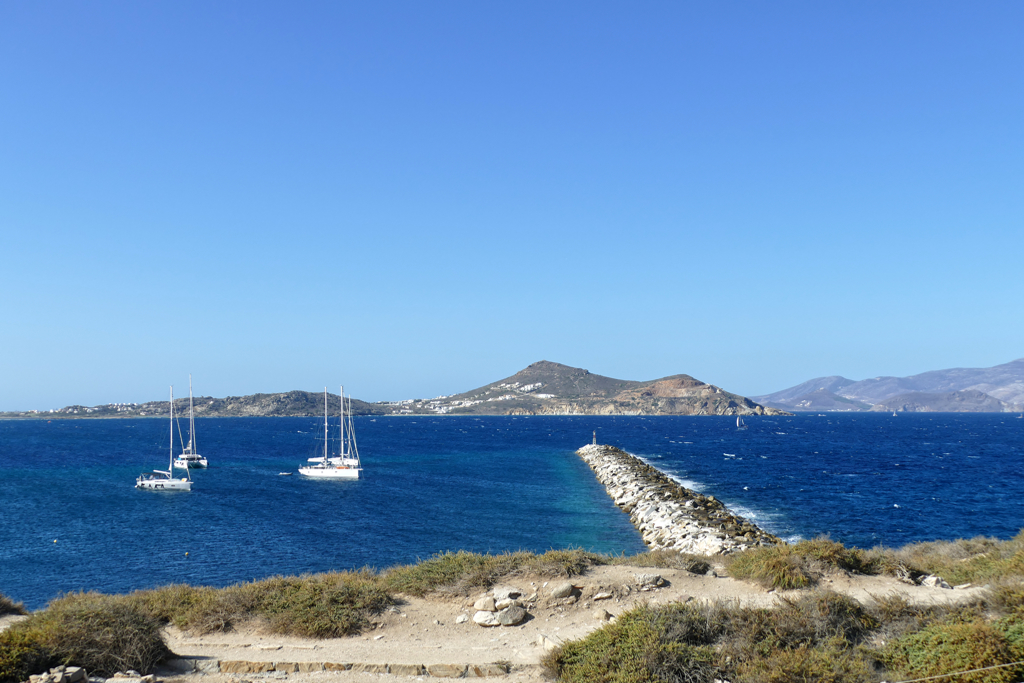
There are various companies offering tours by speedboat to pristine bays, which often include stops for some great snorkeling.
Organized Trips
Since there might be only a few connections per day to some of the spots I’m introducing above, you might prefer going on an organized day trip. Also, exploring Naxos from the water is a very special experience that you should book organized.
And finally, spending a lovely day out in the company of strangers – who then might become friends – is always a treat even for a dedicated solo-traveller like myself. Therefore, check out these promising activities*:
Where to Stay
There are hotels, guest houses, apartments, and private rooms in each hamlet around the island. Already due to the fact that I was relying on public transport, choosing accommodation in Naxos’ Chora was very convenient. Also, I was renting a self-catered apartment in a totally non-touristy residential area, which I loved. This way, I really felt at home away from home. A local supermarket and a bakery were across the street, and the port with all its tourist infrastructure was a short ten-minute walk away, and so was the Agios Georgios Beach. If you are like me and do enjoy local color over globalized luxury, Little Yard Studios & Apartments* are the perfect choice for you.
I had a spacious living room with an integrated kitchenette, a bathroom, and a nice bedroom. No frills, but squeaky clean and at night very quiet.
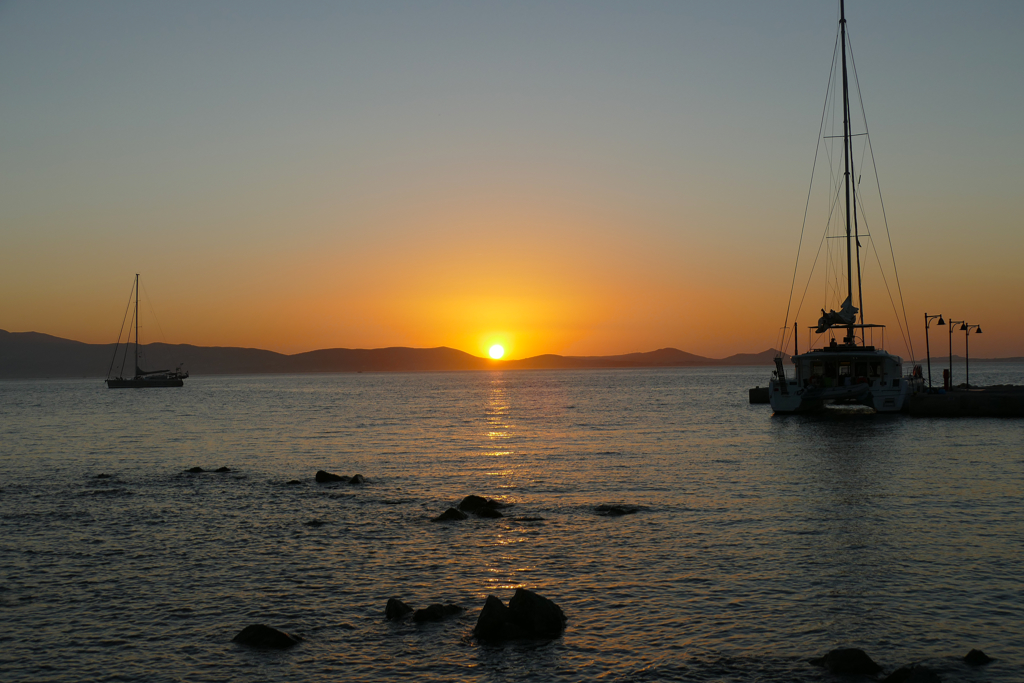
If the Little Yard Studios & Apartments* should be booked out or if you are simply going for the service of a hotel or prefer to be right on the beach, you’ll find a great choice of lodging options for every taste and every budget*:
What to Eat
No offense, but I’d argue that Greece is not a destination for self-proclaimed gourmets. There are tons of food everywhere, however, the classic cuisine is intended to fill you up and definitely not refined. Also, Greeks prefer their food to be lukewarm, and that’s how it is served in the taverns.
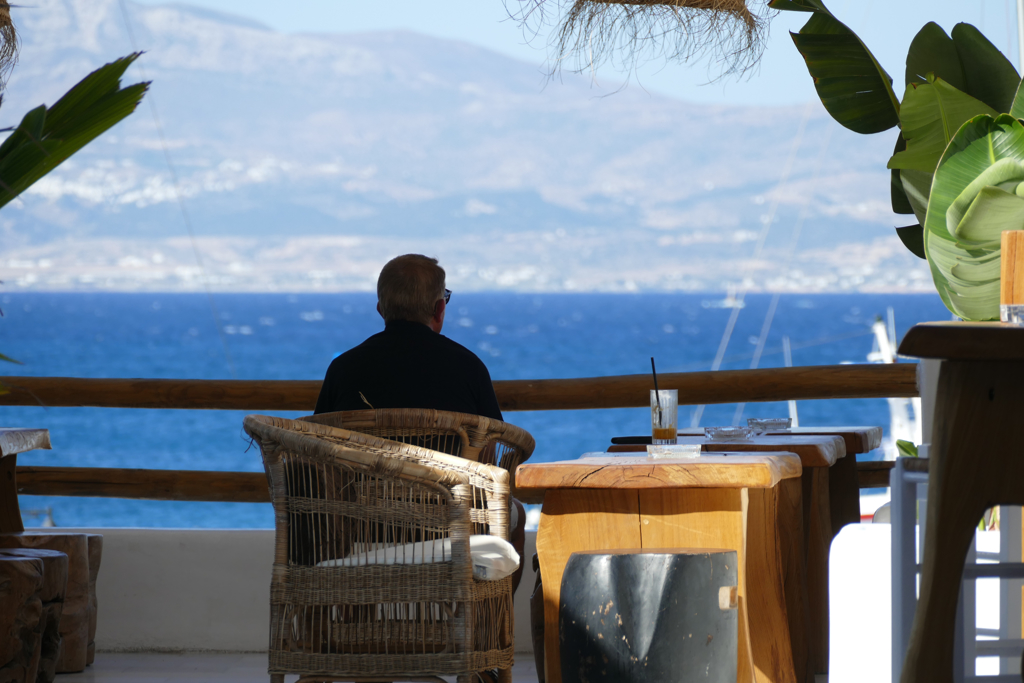
In most restaurants that cater to tourists, you’ll find all the dishes you know from your Greek restaurant back home: Gyros, Souvlaki, Bifteki, and the like. All very much on the meaty side. It’s not easy to find varied vegetarian, let alone vegan, food. The best alternative is probably Greek salads.
In Naxos, the street alongside the harbor is lined with restaurants serving exactly these staples, advertising them as traditional Greek cuisine. Albeit, a bit of fish is added, too.
A very reasonably priced snack bar where you can have your Gyros pita or a complete meal, either to go or on the spot, is Yasouvlaki, located pretty much at the southern end of Chora’s Protopapadaki street.

When it comes to breakfast, just enjoy your morning coffee at one of the bars or bakeries, if your hotel does not offer any breakfast.
There are many bakeries selling all kinds of sandwiches as well as sweet’n’hearty-filled pastries. Obviously, they also have all kinds of bread, pies, and cookies.
Definitely recommended for breakfast, but also to stock up on snacks, for instance, for a long day on the beach.
Cash And Cards
Since 2001, 20 European countries have been paying with €uros, and Greece is, obviously, one of them. The exchange rate is 1 US$ = 0,85 EUR as of August 2025, but you can check the conversion on this page.
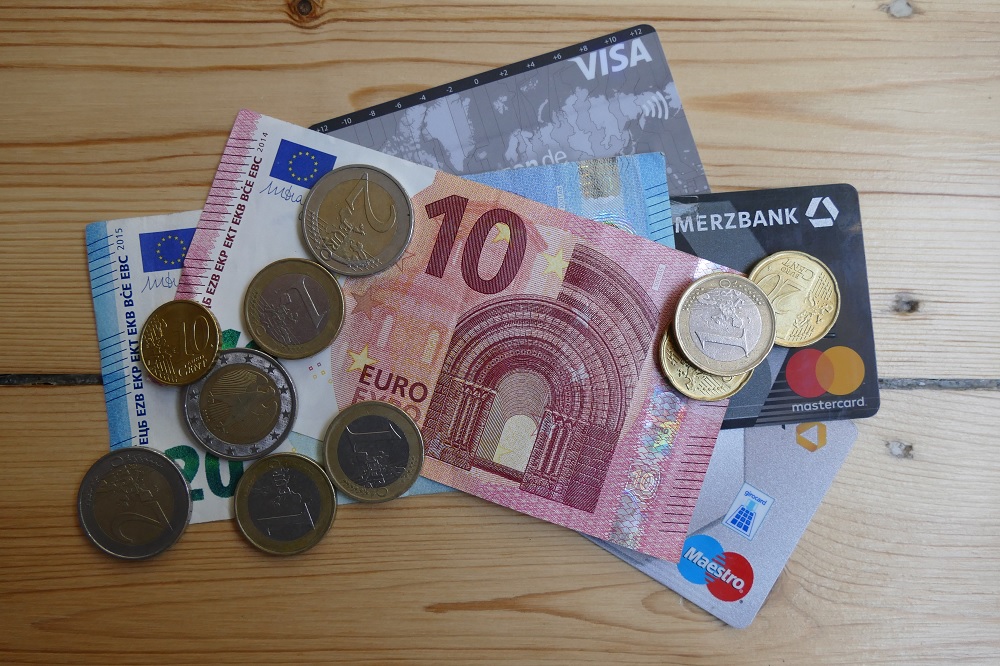
Especially in the aftermath of the COVID pandemic, even small businesses prefer that you pay by credit card, and preferably contactless.
However, I was also asked if I could pay cash – even for hotel rooms. Obviously, this makes business for locals more profitable, if you know what I mean. In return, they gave me a slightly better price.s.
Language
The Greek language had an immense impact on the development of Europe: Both the Latin and the Cyrillic alphabets were developed on the basis of the Greek alphabet. Also, the New Testament was written in classic Greek and is still read in the original version during Greek church services. Only the fall of the Byzantine Empire in 1453 marks the end of the Medieval Greek period.
This is when the era of today’s version of the Greek began.
To this date, scientific terms stem directly from classic Greek – and Latin, obviously.
Although Greek is such a significant language, not many foreigners speak it. But basically, all Greeks working in tourism and gastronomy speak quite decent English. However, it’s always nice to be able to say at least some pleasantries in the local language so you might want to pick up some words for instance on Lingohut. This online program offers an amazing choice of more than 45 languages!
By the way, in general, menus, timetables, street signs, and other important information are written in both Greek and Latin letters. Nevertheless, to make things easier for you, below is a list of Greek letters and their respective translation.
Greek Alphabet
| Upper Case Letter | Lower Case Letter | Greek Name | English Name |
|---|---|---|---|
| Α | α | Alpha | a |
| Β | β | Beta | b |
| Γ | γ | Gamma | g |
| Δ | δ | Delta | d |
| Ε | ε | Epsilon | e |
| Ζ | ζ | Zeta | z |
| Η | η | Eta | h |
| Θ | θ | Theta | th |
| Ι | ι | Iota | i |
| Κ | κ | Kappa | k |
| Λ | λ | Lambda | l |
| Μ | μ | Mu | m |
| Ν | ν | Nu | n |
| Ξ | ξ | Xi | x |
| Ο | ο | Omicron | o |
| Π | π | Pi | p |
| Ρ | ρ | Rho | r |
| Σ | σ,ς | Sigma | s |
| Τ | τ | Tau | t |
| Υ | υ | Upsilon | u |
| Φ | φ | Phi | ph |
| Χ | χ | Chi | ch |
| Ψ | ψ | Psi | ps |
| Ω | ω | Omega | o |
Connection and Communication
Since June 2017, no roaming charges apply within the EU with a European mobile phone contract. This applies to all 27 countries of the European Union as well as Iceland, Liechtenstein, and Norway. It pertains to all contracts.
When roaming is unavailable, you can connect to the internet at basically every museum, eatery, and hotel.
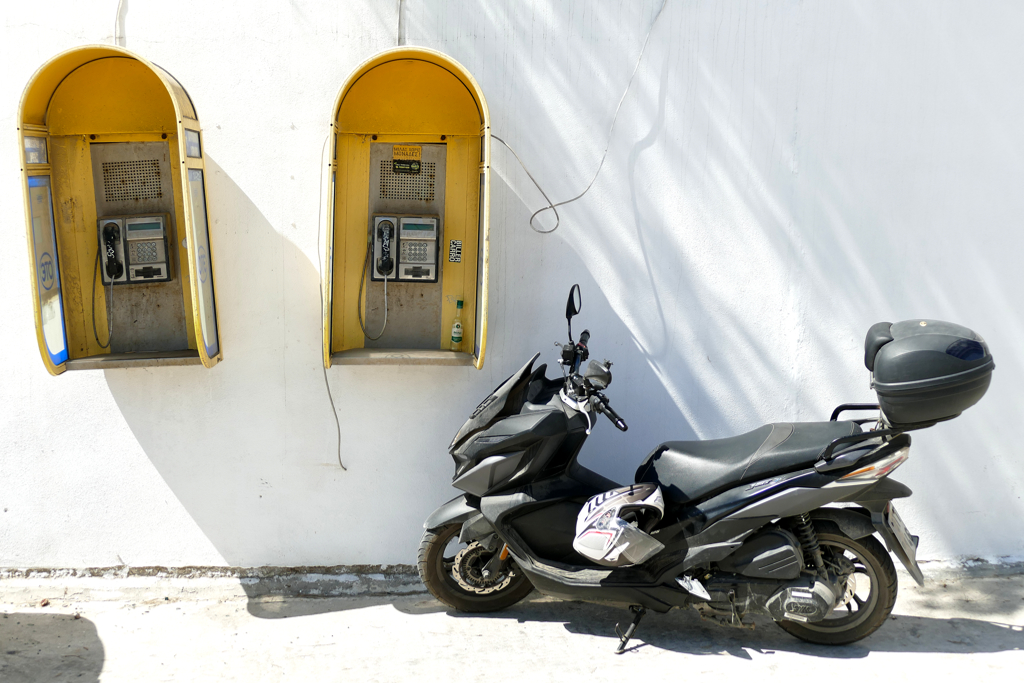
You can get a SIM card if you insist on being online 24/7. The most popular ones are from COSMOTE, Vodafone, and WIND. You can get them for 5 €uros in their respective stores.
In Greece, they use plug types C and F. Their voltage is 230 V, and the frequency is 50 Hz. Whereby, as nowadays all these chargers have integrated adapters, in general, the voltage and frequency don’t really matter.
By the way, you’ll find comprehensive travel info in my post World’s Most Complete Travel Information – an indispensable globetrotter classic.
Map
On this map, you can see where all the wonderful places that I’m introducing in this post are located. This way, you can put together your itinerary accordingly.
Clicking on the slider symbol at the top left or the full-screen icon at the top right will display the whole map, including the legend:
Pinnable Pictures
If you choose to pin this post for later, please use one of these pictures:
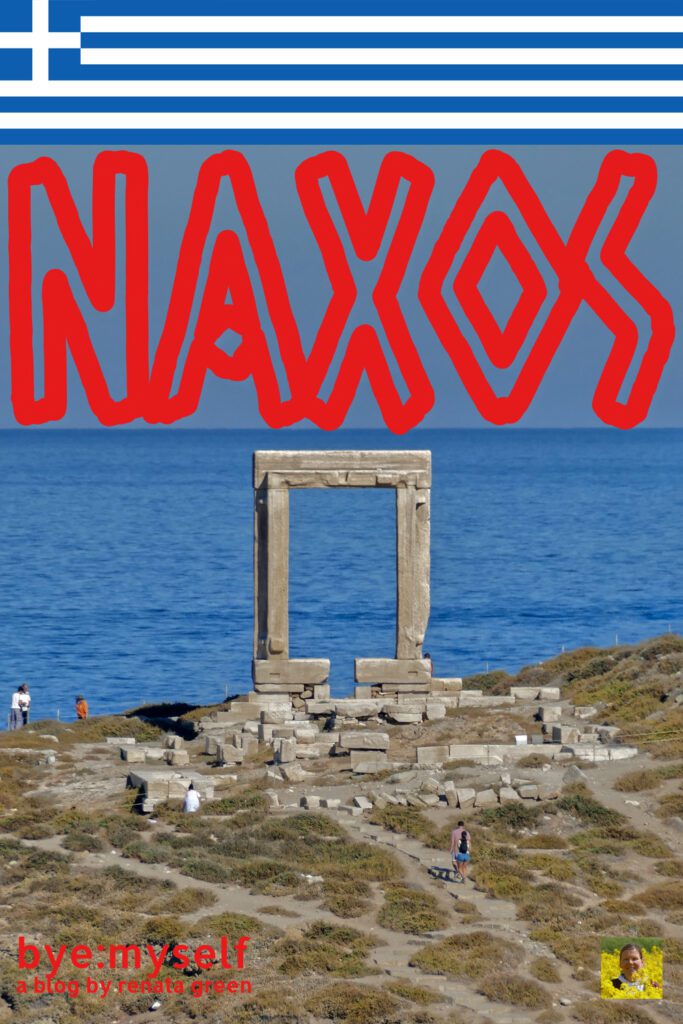

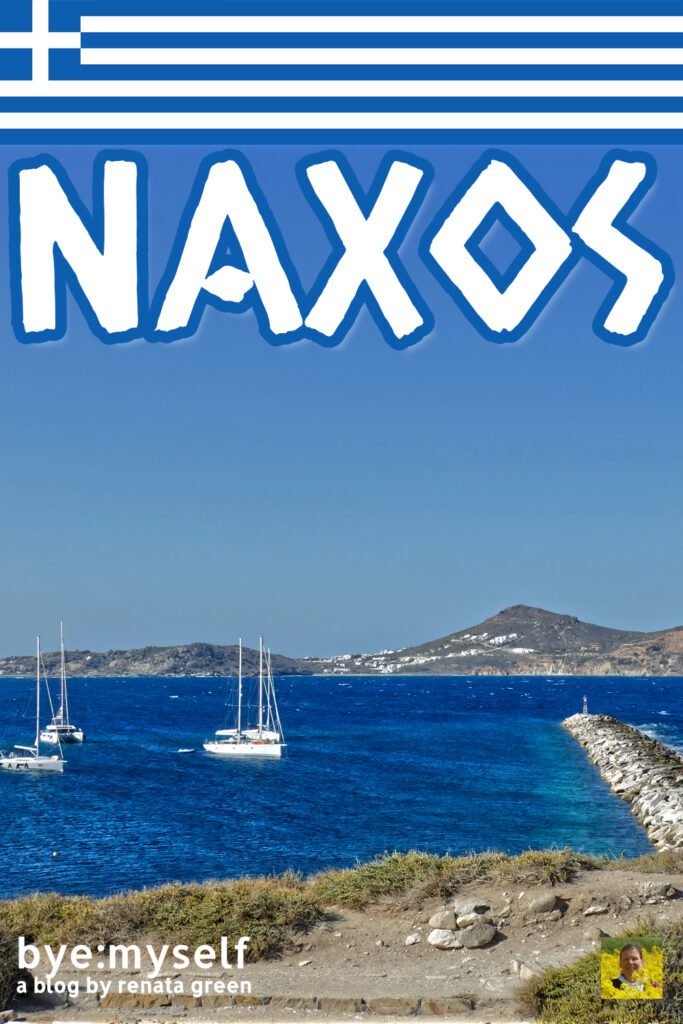
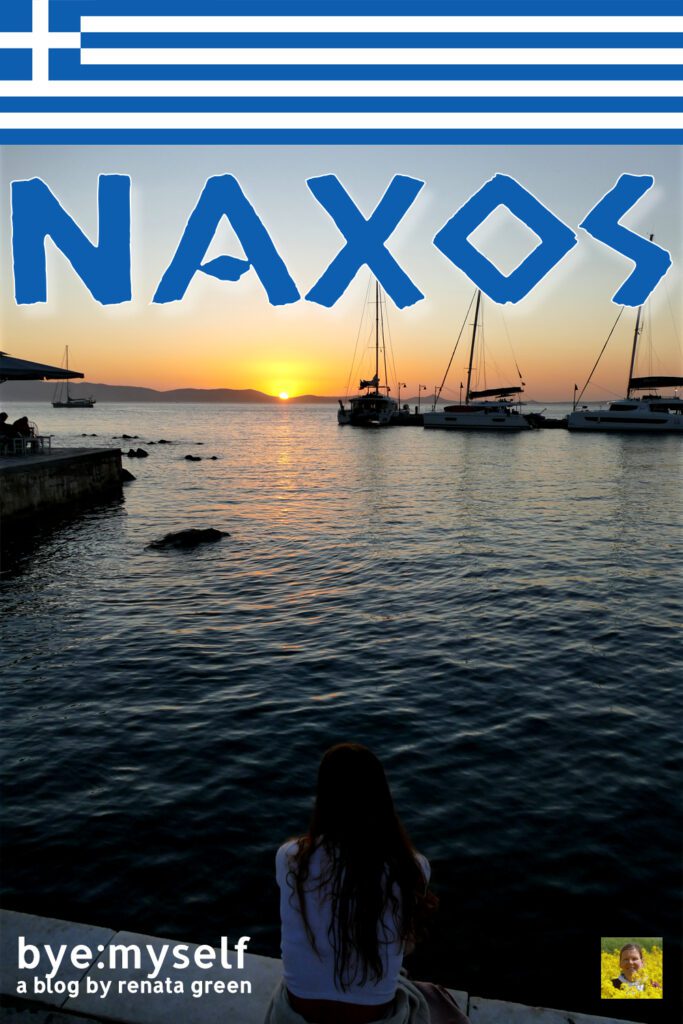


Note: This post is being regularly completed, edited, and updated – last in August 2025.
Did You Enjoy This Post? Then You Might Also Like These:
Day Trip to RETHYMNO
The Island of IOS During Off-Season
Rocking it in METEORA: Monasteries and Beyond
The Best and Most Beautiful Beaches of Naxos
BALOS and GRAMVOUSA – Crete’s Most Excellent Beaches
Best Things to Do in CHANIA – And the Finest Beaches Just a Short Walk Away
Day Trip to AGIOS NIKOLAOS – Crete’s Easternmost Gem
Best Things to Do in CRETE in One Week
* This is an affiliate link. If you book through this page, not only do you get the best deal. I also get a small commission that helps me run this blog. Thank you so much for supporting me!
